

0324-B2
Stanislav Vacek, Vratislav Balcar 1
Forest management in the Czech Republic (CR) was not shaped in the environment of natural forests but in the territory that was influenced by unregulated felling and animal grazing for a long time. Hence the fear for sustainable and balanced benefits from forests endangered by long-term uncontrolled exploitation was legitimate. Almost after three centuries of application of the sustainability principle, forests are considered not only as a source of renewable wood raw material but also as a tool of the environment formation.
Mountain forests are an important landscape component of this country. They are an object of specific importance from the aspect of natural environment conservation, stabilization of natural processes and general landscape homeostasis. In addition, they fulfil a number of production and non-production functions.
Cardinal elements of sustainable forest management in the CR conditions are as follows:
The above cardinal elements of sustainable forest management are applicable to forests of the CR in general, but their importance considerably increases in mountain forests where many species survive on the margin of subsistence. Moreover, mountain forests of CR have been heavily destroyed by anthropogenic factors, especially air-pollution ecological stresses, during the last three or four decenia.
Similarly like in the neighbouring countries of Central Europe, the present condition of Czech forests is a result of cultural, economic and political development. Forest management in this region was not shaped in the environment of natural forests but in the territory that was influenced by unregulated felling and animal grazing for a long time. Hence the fear for sustainable and balanced benefits from forests endangered by long-term uncontrolled exploitation was legitimate (Poleno 1996).
The requirement for sustainable benefits provided by the forest has become one of the basic postulates throughout the centuries. It has been the reason to improve silvicultural technology of forest establishment, tending and regeneration of forest stands that appropriately satisfy the requirements for sustainable and balanced production. But these silvicultural systems have not been sufficiently elaborated until now as can be seen from a high proportion of salvage fellings in the Czech Republic (Fig. 1).
Fig. 1: Development of salvage fellings in the CR according to the types (data of the Forest Management Institute /FMI/ at Brandys n. L.).
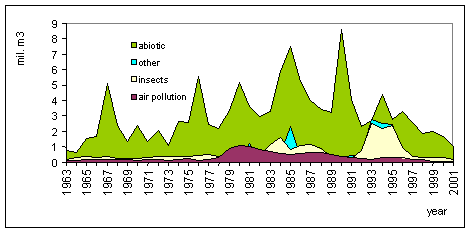
The object of sustainable forest management is a forest ecosystem with its structures, functions, dynamics and stability. In the Czech Republic, this European trend was specified in "Fundamental Principles of State Forest Policy" (1994) and "National Program of Nature and Landscape Conservation" (1998) that were followed by other documents. "Forest Strategy of European Union" (1998) is based on the same principles; it accentuates the multifunctional role of forests and their sustainable management aimed at social, economic, environmental, ecological and cultural functions of forests (Vacek, Balcar 2002).
Mountain forests are an important landscape component of this country. They are an object of specific importance from the aspect of natural environment conservation, stabilization of natural processes and general landscape homeostasis (Vacek, Balcar 2000). In addition, they fulfil a number of production and non-production functions. They involve not only the production of wood, game, forest fruit, etc. but also socially important functions in the sphere of hydrology, soil conservation, climate protection, recreation, nature conservation, biodiversity, etc.
Fig. 2: Mountain regions of CR (GIS K. Matejka - IDS).
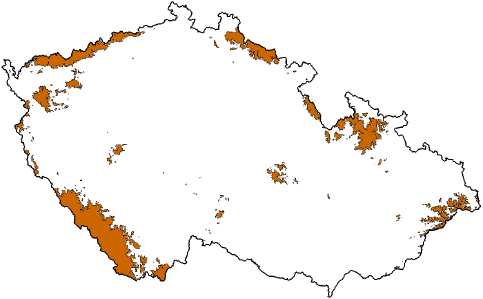
In accordance with the FMI concept, the category of mountain forests comprises forest ecosystems classified into the 6 th - 9 th forest vegetation zones (FVZ), i.e. Beech with Spruce, Spruce with Beech, Spruce and Dwarf Pine zones (Fig. 2). A high proportion of mountain forests in the forest natural regions (FNR) with similar natural conditions of the CR where at least 6 th - 8 th FVZ occur is evident from Fig. 3. Tab. 1 shows FVZ and their proportions in mountain forests of the CR, Table 2 documents the natural, present and target species composition of mountain forests of the CR.
Fig. 3: Forest natural regions of the CR (data of FMI at Brandys n. L.; regions with mountain forests are brown).
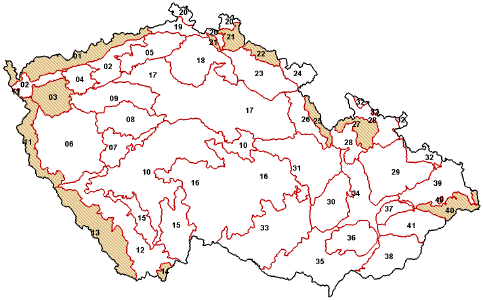
FNR in the Czech Republic are as follows: 1 - Krusne hory Mts., 3 - Karlovy Vary Hills, 11 - Bohemian Forest Mts., 13 - Sumava Mts., 14 - Novohradske hory Mts., 21 - Jizerske hory Mts. and Jested ridge, 22 - Krkonose Mts., 25 - Orlicke hory Mts., 27 - Hruby Jesenik Mts., 40 - Moravian Silesian Beskids Mts.
Besides the wood-producing function, mountain forests of CR fulfil important ecological and environmental functions. In the mountains of CR there are large specially protected areas (national parks and protected landscape areas - Fig. 4) and "small" specially protected areas (particularly national nature reserves and nature reserves), systems of ecological stability (including supra-regional biological centers) and priority biotopes of European Union in the context of NATURA 2000. Establishment of large protected areas was during more than 40 years aimed at protection of the most well - preserved parts of territory with characteristic nature.
Table 1: Characteristics of forest vegetation zones in mountain forests of CR.
| Forest vegetation zone | Forest land area | Proportion of | Altitude | Average temperature | Annual precipitation | Vegetation period | Forest percentage | ||
| FVZ 6-9 | FVZ 0-9 | ||||||||
| ha | % | m | °C | mm | Days | % | |||
| 6 | Beech with Spruce | 309,367 | 67.32 | 11.75 | 700 - 900 | 4.5 - 5.5 | 900 - 1,050 | 115 - 130 | 49.1 |
| 7 | Spruce with Beech | 99,824 | 21.72 | 3.79 | 900 - 1,050 | 4.0 - 4.5 | 1,050 - 1,200 | 100 - 115 | 51.6 |
| 8 | Spruce | 44,522 | 9.69 | 1.69 | 1,050 - 1,350 | 2.5 - 4.0 | 1,200 - 1,500 | 60 - 100 | 91.6 |
| 9 | Dwarf Pine | 5,857 | 1.27 | 0.22 | >1,350 | <2.5 | >1,500 | < 60 | 99.3 |
| * Total forest area in the CR is 2,632,000 ha, of it the area of mountain forests (6 th - 9 th FVZ) amounts to 459 570 ha, i.e. 17.45% (data of FMI at Brandys n. L.). |
Table 2: Natural, present and target species composition in mountain forests of CR.
| Composition | Picea abies | Abies alba | Pinus silvestris | Pinus mugo | Other conifers | |||||
| ha | % | ha | % | ha | % | ha | % | ha | % | |
| Natural | 226,163 | 49.7 | 97,753 | 21.3 | 0 | 0 | 5,142 | 1.1 | 0 | 0 |
| Present | 355,341 | 77.7 | 3,347 | 0.7 | 16,390 | 3.6 | 5,461 | 1.2 | 20,104 | 4.4 |
| Target | 346,516 | 75.4 | 56,475 | 12.3 | 742 | 0.2 | 5,084 | 1.1 | 0 | 0 |
Composition |
Fagus sylvatica |
Betula pendula. B. pubescens |
Alnus glutinosa. A. incana |
Sorbus aucuparia |
Other broadleaved | |||||
| ha | % | ha | % | ha | % | ha | % | ha | % | |
| Natural | 118,358 | 25.7 | 8,896 | 1.9 | 309 | 0.1 | 291 | 0.1 | 2,683 | 0.6 |
| Present | 22,133 | 4.8 | 16,001 | 3.5 | 6,565 | 1.4 | 10,644 | 2.3 | 3,581 | 0.8 |
| Target | 48,324 | 10.5 | 1,887 | 0.4 | 62 | + | 290 | 0.1 | 835 | 0.2 |
| Data of FMI at Brandys n. L. (J. Macku). |
Mountain forests have positive soil-conservation and hydrological functions. Forests in mountain locations do not influence only the environment of the site where they grow, they also produce remote effects. They fulfill erosion and flood control functions and ensure water supplies in the production landscape at lower altitudes. Mountain forests are specific areas with increased interest in the soil-protection function of forests, and they are classified as hydrologically important forests.
Fig. 4: Large specially protected areas (CHKO = Protected Landscape Areas and NP = National Parks) in the CR (data Agency for nature conservation and landscape protection of the CR; GIS K. Matejka -IDS).
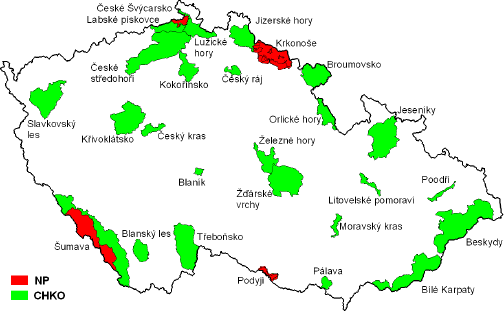
Research of sustainable forest management has been performed on the base of published works and results of investigation in network of research, monitoring, and pilot plots and areas. Principal problem of present Czech mountain forests influenced by air pollution stress is to maintain their stability and biodiversity, as the chief preconditions for sustainability. Main types of the Czech mountain forest ecosystems were analysed, in order to investigation of disturbances and modifications of relations into woody plant component of ecosystem. Obtaining results were checked and applied for management measures formulation, aimed to the "available" stability formation of studied mountain forest ecosystems growing in various ecological conditions. As tools for solution of the mentioned problems, besides silvicultural, dendrometrical and forest management procedures, also ecological, climatological and biometrical investigation methods were used.
Research attention was paid to 10 of the FNR (Fig 3). Performance of ecosystems was continually or periodically investigated on representative studied areas and plots. Attention was not only paid to woody species (growth, injury, mortality etc.), but performance of other ecosystem components were studied as well (insects, fungi, herbs, soil, air pollution). Applied assessment methods (including statistics) see Vacek (1996).
All mountain forests in the Czech Republic have been exposed to air pollution since the 50ies - 80ies of the twentieth century. Quality, quantity and time dynamics of air-pollution stress have been monitored to describe the type and extent of damage to forest ecosystems (ICP Forest, etc.) that have crucial consequences for the choice of tree species composition in regeneration targets. To set up the fundamental principles of tending and regeneration, the anticipated dynamics of forest stand damage by air pollutants is taken into account. Potential effects of air pollution upon forests have been expressed by pollution threat zones (zones A - D) delimitation (Fig. 5). The zones are the areas where the shortening of lifetime of mature spruce forests shows a relatively similar trend under the influence of air pollutants, climatic, orographic and site conditions and genetic characteristics of forest stands.
Fig. 5: Zones of risk of exposure of forest stands to air pollution in the CR (data of FMI at Brandys n. L., 2001; GIS Karel Matejka - IDS).
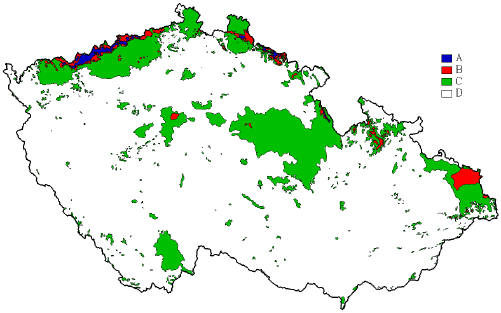
We have witnessed an obviously deteriorating condition of forests at mountain locations since the early seventies (in Krusne hory Mts. since the mid-sixties). Dynamic disintegration of forest, decrease in its production functions, failure of its ecological and environmental functions and disappearance of tree species genetic resources have immense ecological and social consequences. The most afflicted area in Central Europe - "black triangle" - involves Krusne hory Mts., Jizerske hory Mts. and Krkonose Mts. (cf. Vacek, Balcar 2002a). After declining forest stands were felled (47,300 ha since 1958, i.e. ca. 2% of forests), there arose problems of forest regeneration on vast clearings due to salvage felling. In general, the situation was worst in protection mountain forests that were neglected for economic reasons for a long time (Tesar 1993). Thus in the seventies continuous, old spruce stands approaching the physical age generally prevailed e.g. at higher locations of the Sudetes (Vacek et al. 1997). The situation was similar in other mountain regions of the CR. These stands were exposed to natural disintegration without sufficient regeneration that was largely damaged, or many times fully destroyed, by high stocks of hoofed game. The stands in such condition were affected by air-pollution ecological stresses. Very dynamic, locally general destruction of forest stands due to air pollution and concomitant climatic extremes, insect pests and fungal pathogens, and subsequent felling of declining or declined stands, produced a highly unfavorable ecological situation for the origination of successive forest stands.
Cardinal elements of sustainable forest management in the Czech Republic's conditions are as follows:
The above cardinal elements of sustainable forest management are applicable to forests of the CR in general, but their importance considerably increases in mountain forests where many species survive on the margin of subsistence (Vacek et al 1997). Moreover, mountain forests of CR have been heavily destroyed by anthropogenic factors, especially air-pollution ecological stresses, in the last three or four decenia.
Management complexes (MC) are fundamental super-structural units of forest typology for forest operations and forest planning in the CR. The framework of permanent natural conditions in these complexes is constituted by cognate management of associated "forest site type groups" that have common target methods and forms of management and target tree species composition. There are 24 target MC in the category of commercial forests that are also applicable to special-purpose forests, and 3 MC in the category of protection forests.
Management of forests at the highest locations, i.e. in Dwarf Pine, Spruce and Spruce with Beech forest vegetation zones, and in the remaining mountain locations of lower altitudes is completely different. In the first case, it is management at elevated mountain locations (MC 71 - exposed, 73 - acid, 75 - fertile, 77 - gleyic and 79 - water-logged sites of mountain locations) and in respective protection forests (MC 01, 02 and 03, i.e. extremely unfavorable sites, high-elevation forests below the forest limit, forests in the dwarf pine vegetation zone). A spruce forest or a forest with dominant Norway spruce grows in almost marginal conditions of subsistence and is strongly exposed to air pollution (Fig. 6). The disintegration of older, particularly allochthonous stands is inevitable at these locations; therefore their regeneration should start as soon as possible. On the other hand, complex silvicultural measures can prolong the lifetime of young and medium-age stands and of many older autochthonous stands.
Fig. 6: Formation of a regeneration basis in the parts of the Jizerske hory Mts. exposed to heavy air pollution (photo by S. Vacek).
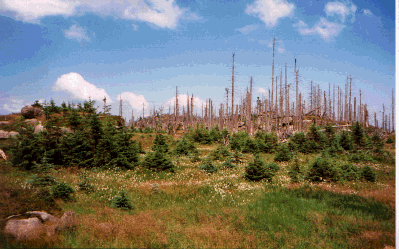
Fig. 7: Small-area regeneration elements at lower locations of the Orlicke hory Mts. (photo by S. Vacek).
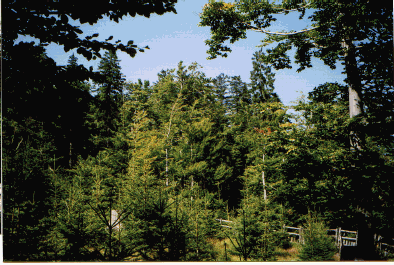
Management at lower mountain locations (MC 51, 53, 55, 57, 59, i.e. management of exposed, acid, fertile, gleyic and water-logged sites at higher altitudes) in the Beech with Spruce and Beech with Fir vegetation zones with much lower air pollution stress (Fig. 7). As the dynamics of damage is slower, so called conservation strategy trying to maintain the present stands in a functional condition as long as possible can be applied intentionally (Tesar 1993).
It is advisable to apply a set of preventive measures aimed at stabilization of the internal stand structure (optimally expanded crowns, closed canopy, etc.), adjustment of the species and ecotype structure (preference of tolerant autochthonous species), and silvicultural (biological and chemical) reclamation.
As the social requirements for forests to fulfill not only production but also ecological or environmental functions were increasingly accentuated, methods of multifunctional mountain forest management were gradually elaborated. Simultaneously, forest owners and the public increasingly claimed rationalization of management methods and economic autonomy of forest property. Accordingly, to ensure sustainable as well as economically efficient management of mountain forests appropriate methods of management of forest stands are sought, with maximum use of creative forces of the nature.
The rational trend of sustainable management of mountain forests set in the CR in the nineties brought about a new quality of the approach to forest stands that is markedly different from a large-area clear-cutting system used mainly in the seventies and eighties, when the biological nature of the forest was neglected. The tradition of shelterwood forest management practiced by enlightened forest managers before World War II and still in the fifties and sixties was resumed. Current trends of sustainable forest management are based on maximum utilization of the existing knowledge of forest typology and forest ecosystem ecology. Such an approach in today's forest political environment of the CR and close joining in the present pan-European forest environment allow to make great progress toward the acceptable ecosystem-based forest management, particularly by uniting scientific knowledge and extensive silvicultural experience within this country and adjacent European countries as well.
Poleno, Z., 1996. Sustainable management of forests in the Czech Republic. Praha, MZe CR, 61 p.
Tesar, V., 1993. Obhospodarovani horskeho lesa Ceskeho masivu v soucasnych ekologickych pomerech. In: Hospodarenie v lesoch horskych oblasti. Ed. M. Hladik. Pisek, Matice lesnicka, pp. 11 - 31.
Vacek, S. (ed.), 1996. Monitoring, vyzkum a management ekosystemu na uzemi Krkonosskeho narodniho parku. (Monitoring, research and management of ecosystems in the Krkonose National Park region.) Sbornik prispevku z mezinarodni konference ... Opocno, 15 - 17. 4. 1996. Opocno, VULHM - Vyzkumna stanice, 350 p.
Vacek, S., Lokvenc, T., Balcar, V. and Henzlik, V., 1997. Obnova a stabilizace lesa v horskych oblastech Sudet. (Forest regeneration and stabilization in the Sudeten mountain regions). In: Protection of forest ecosystems, selected problems of forestry in Sudety Mts. Eds. P. Paschalis, S. Zajaczkowski. Wyd. 2., niezm. Warszawa, pp. 93 - 119.
Vacek, S. and Balcar, V., 2000. Sudeten Mountains in the Czech Republic - growing conditions, regeneration and stabilization of mountain forests. In: Multipurpose management of mountain forests: concepts, methods, techniques. Symposium international. Communications. Pralognan-la-Vanoise, France, 25-30 June 2000. EOMF, IUFRO, pp. 168 - 177.
Vacek, S. and Balcar, V., 2002. Strategy of Forest Restoration in the Czech Part of the "Black Triangle". In: Documenting Forest Restoration Knowledge and Practices in Boreal and Temperate Ecosystems. Vejle, Danmark, 28. 4. - 3.5. 2002, IUFRO, pp. 147 - 148.
Vacek, S. and Balcar, V., 2002a. An approach for conciliating public expectations and biological capaties. In: The formulation of integrated management plans (IMPs) for mountain forests. 30. 6. - 5. 7. 2002, Bardonecchia, Italy, EOMF, Universita di Torino, pp. 59 - 66.
1 Forestry and Game Management Research Institute, Jiloviste-Strnady,
Opocno Research Station, 517 73 Opocno, Czech Republic
E-mail: [email protected]